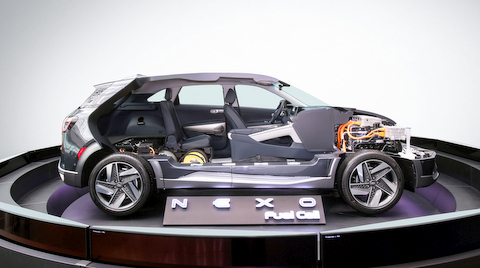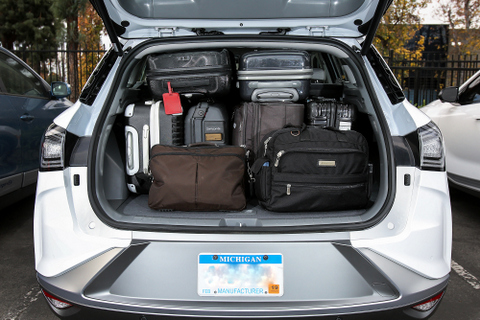Fuel Cell SUV Passes Crash Test
The latest news on the Hyundai Nexo Fuel Cell Electric is that it has become the first fuel cell car evaluated by the Insurance Institute for Highway Safety. The IIHS awarded the SUV a Top Safety Pick+ mark for its good ratings in the driver-side small overlap front, passenger-side small overlap front, moderate overlap front, side, roof strength and head restraint tests. It also had an advanced or superior rating for front crash prevention and a good headlight rating.
The Nexo, a midsize SUV, has good ratings in all six crashworthiness tests. Its competition, the Toyota Mirai and Honda Clarity Fuel Cell, have not been tested by the IIHS or the official government safety testing agency, the National Highway Traffic Safety Administration.
Our Drive
Hyundai’s flipped the script. Unlike the space-ship-like “cars of the future†designed in the 1950s, the 2020 Hyundai Nexo fuel cell electric vehicle (FCEV) looks like your bread-and-butter midsize SUV, ready to haul kids to soccer practice and brave the wilds of a Costco parking lot. The control panel to the right of the driver looks a little as if it was originally designed for an episode of Star Trek, but unlike those panels, it is connected to a functioning machine.

The Hyundai car-of-the-future script plays out surprisingly mundane. The Nexo, slated in size between the brand’s Tucson and Santa Fe models, can carry five adults in quiet comfort, drives like an electric crossover should (i.e., fast and smooth), swallows up five person’s luggage in almost 30 feet of cargo space, refuels in five minutes and functionally could replace your current SUV. However, there’s one big BUT. You’ve got to live in proximity to the just-developing hydrogen fueling network in California.
Déjà vu
Hyundai’s first fuel cell car, a modified Santa Fe, debuted in 2000 and “everyday use†models were promised in 2005. The company missed that mark by a decade, but finally started leasing 2015 Tucson fuel cell vehicles in 2014, continuing until the Nexo was introduced last year. The commitment to use a crossover as the basis for an FCEV showed some practicality on Hyundai’s part. That model has more space available for fuel tanks and other technology in development. What’s impressive is that by the time the Nexo arrived, all of the additive technology was tucked out of the way, so functionally the SUV is indistinguishable from its gas-powered counterparts.

Driving the Nexo recalled earlier drives of the Santa Fe FCEV and Tucson FCEV (and the early Toyota Highlander FCEV). Acceleration was crisp, hindered only by the heft of a 4,000-pound vehicle being propelled by a 120 kilowatt (kW, or 161 horsepower) permanent magnet electric motor. The torque is there on launch, but proceeds in a flat line, so unlike a typical gas-powered engine, there’s not a growing sense of speed. System power comes from a 95 kW fuel cell stack and a 40 kW battery. The front-wheel drive car also has a regenerative braking system that feeds energy to the battery for later use.
Handling in the Nexo was good, striking a balance between a few high-end SUVs that like to pretend they’re sports car wagons and low-end ones that have all the numbness on the road of an Eighties Detroit wagon. Road feel was there, and the car responded nimbly to inputs to the motor-drive power steering.
Limited Audience
The 2020 Hyundai Nexo will be in limited supply to a limited market. By design, the car will only be sold to customers who live in proximity to the current 39 hydrogen fueling stations in California (that number is due to double over the next couple years). The move is designed to limit disappoint in potential buyers who might spend a substantial amount of time and travel tracking down a refueling spot. With up to 380 miles of range when full, a fuel cell vehicle gives you a pretty long leash to roam. The base model of the Nexo has an EPA mileage estimate of 65 MPGe city/58 highway/61 combined. When dealing with alternative fuel vehicles like FCEVs and BEVs, the range number tends to be more significant since the MPGe number is more of a technical comparison between vehicles.

Hyundai sold or leased 119 Nexo in the first six months of 2019. Company representatives told Clean Fleet Report that the number available in the U.S. will be limited because a single low-volume factory is serving them up for the whole world. Lease deals are the preferred way to get behind the wheel of the $58,300 Nexo Blue (the upgraded Limited starts at $61,800); Hyundai is offering a three-year, $399/month deal on the car with $2,999 down. Included in the basic package is a healthy list of advanced safety technology, such as forward collision-avoidance assist, blind-spot collision warning, rear cross-traffic collision warning, parking distance warning, lane follow assist (which includes lane keeping assist and departure warning), driver attention warning, high-beam assist and a half-dozen airbags.

The 2020 Hyundai Nexo FCEV is ready to go toe-to-toe with traditionally powered competitors as well as battery electric competitors. It’s main attraction is its unique powertrain and the unique platform Hyundai is using. If you want a fuel cell, but don’t care for a crossover, the Toyota Mirai and Honda Clarity sedans are your only options. If you want an electric crossover, choices are likewise limited, with the Tesla Model X, Jaguar I-Pace and Audi E-Tron the only real competition. The Hyundai Kona EV and Kia Niro EV are smaller. The field is small, but expect to see more entrants during the coming year or two.
In order to give you the best perspective on the many vehicles available, Clean Fleet Report has a variety of contributors. When possible, we will offer you multiple perspectives on a given vehicle. This comes under SRO-Second Road Test Opinion. We hope you’ll enjoy these diverse views–some are just below—and let us know what you think in comments below or at publisher@cleanfleetreport.com.
Steve and Gary have both done full road tests on the 2019 Hyundai Nexo (there are minimal changes for 2020). In addition, Gary covered the first Northern California Nexo delivery.
Make sure to opt-in to the Clean Fleet Report newsletter (top right of page) to be notified of all new stories and vehicle reviews.
Disclosure:
Clean Fleet Report is loaned free test vehicles from automakers to evaluate, typically for a week at a time. Our road tests are based on this one-week drive of a new vehicle. Because of this we don’t address issues such as long-term reliability or total cost of ownership. In addition, we are often invited to manufacturer events highlighting new vehicles or technology. As part of these events we may be offered free transportation, lodging or meals. We do our best to present our unvarnished evaluations of vehicles and news irrespective of these inducements.
Our focus is on vehicles that offer the best fuel economy in their class, which leads us to emphasize electric cars, plug-in hybrids, hybrids and diesels. We also feature those efficient gas-powered vehicles that are among the top mpg vehicles in their class. In addition, we aim to offer reviews and news on advanced technology and the alternative fuel vehicle market. We welcome any feedback from vehicle owners and are dedicated to providing a forum for alternative viewpoints. Please let us know your views at publisher@cleanfleetreport.com.

25 thoughts on “Flash Drive/News: 2020 Hyundai Nexo FCEV”